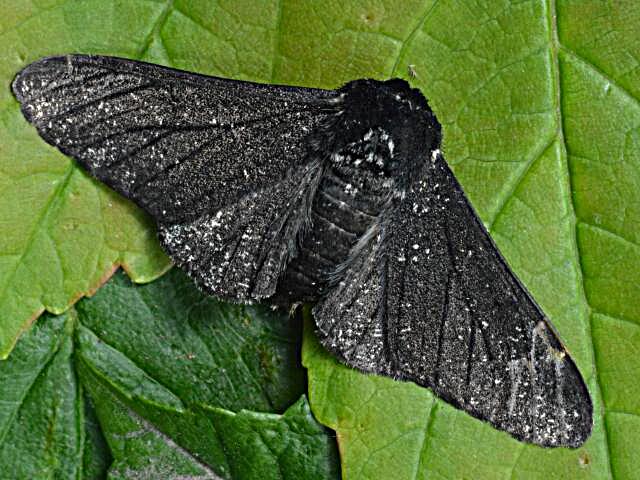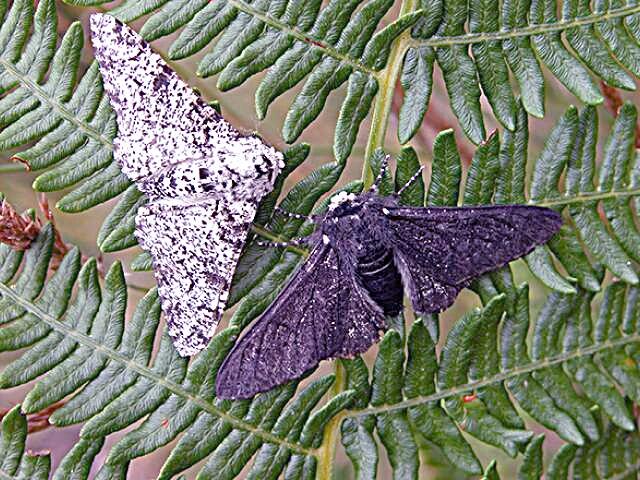Bernard Kettlewell investigated the famous case of industrial melanism in peppered moths. He determined if moths with darker coloration had a survival advantage in polluted areas.
Kettlewell marked and released moths in both industrial and rural environments, finding that dark moths were better camouflaged in polluted areas, while light moths thrived in unpolluted areas.
This provided compelling evidence for natural selection, illustrating how environmental changes can drive the evolution of traits in populations over time.
How did Kettlewell choose study locations?
Kettlewell’s experimental design was meticulous and well-thought-out. It involved selecting appropriate study locations, marking and releasing moths for tracking, and collecting data through recapture.
In addition, repeating the experiments across multiple generations provides a comprehensive understanding of how moth coloration influenced their survival in different environments.
Selection of Study Locations

Kettlewell carefully chose study locations in England to conduct his experiments. These locations were strategically selected to encompass a range of environmental conditions.
He included industrialized areas with high levels of pollution, such as those near factories and cities, and contrasted them with unpolluted rural areas with cleaner air.
Furthermore, the choice of these contrasting environments was crucial to test whether moth coloration provided a survival advantage in different ecological settings.
Marking and Releasing Moths
Kettlewell captured peppered moths from both the industrial and rural areas. To distinguish between moths from different populations and track their survival rates, he marked them with a small dab of paint on their wings. This marking was a crucial part of the experimental design.
Marking allowed Kettlewell to release the moths back into their respective environments and later recapture them without confusing them with new individuals. The marking and release process ensured that the same moths were being studied over time, providing accurate data on their survival.
Data Collection and Recapture Methods
After marking and releasing the moths, Kettlewell began collecting data on their survival rates.He periodically recaptured moths from both industrial and rural areas to assess their fate.
Kettlewell recorded the number of marked moths (those he had released) and unmarked moths (those from the wild population) that he recaptured.
By comparing the ratios of marked to unmarked moths in each environment, he could determine whether one color variant had a higher or lower survival rate.
Repetition of Experiments Over Multiple Generations
Kettlewell didn’t stop at a single set of experiments; instead, he conducted his research over several generations of moths. This long-term approach allowed him to observe trends and confirm the consistency of his findings.
Moreover, it also accounted for the possibility of natural fluctuations in moth populations and environmental conditions over time, ensuring that the results were robust and not a one-time anomaly.
Repetition over multiple generations strengthened the credibility of his conclusions regarding the role of moth coloration in survival.
What did Kettlewell discover about moth survival?
Kettlewell’s findings demonstrated that the peppered moth’s coloration played a crucial role in its survival in different environments.
In addition, these findings not only provided strong support for the theory of natural selection but also showcased how rapidly populations can adapt to changing environmental conditions,
Survival Advantage of Dark-Colored Moths in Polluted Industrial Areas
Kettlewell’s research revealed that in industrialized areas with high pollution levels, moths with darker coloration had a significant survival advantage over their lighter counterparts.
The reason behind this advantage was camouflage.
Dark-colored moths were better suited to blend in with the soot-covered trees and structures in polluted environments. As a result, they were less likely to be detected by visual predators like birds during the day, leading to a higher survival rate.
Over time, the population of dark-colored moths increased in industrial areas because they were better adapted to their environment, a clear example of natural selection in action.
Survival Advantage of Light-Colored Moths in Rural, Unpolluted Areas
In contrast, Kettlewell found that in rural areas with cleaner air and unpolluted environments, light-colored moths had a survival advantage.
These moths, with their speckled appearance, were better camouflaged against the lichen-covered tree trunks in rural settings.
Moreover, predators had a harder time spotting them on the lighter backgrounds, giving light-colored moths a higher chance of surviving and reproducing. This led to a higher prevalence of light-colored moths in rural areas.
Implications for Natural Selection and Adaptation
Kettlewell’s research had profound implications for our understanding of natural selection and adaptation in populations of living organisms. Moreover, it provided empirical evidence that environmental changes, such as industrialization and pollution, could drive changes in the traits of a population over time.
In the case of the peppered moths, the shift in coloration within a relatively short time span was a striking example of adaptation to local conditions.
The moths that were better suited to their environment had a higher likelihood of surviving, reproducing, and passing on their advantageous traits to the next generation. This is a fundamental concept of natural selection.
Kettlewell’s work became a classic example of how evolutionary forces act on populations, highlighting the dynamic relationship between an organism’s traits and its environment.
How did Kettlewell’s research impact our understanding of adaptation?

Kettlewell’s research with peppered moths left an indelible mark on the field of biology. It not only confirmed the principles of natural selection but also provided a vivid illustration of how adaptation can occur in real-world scenarios.
Kettlewell’s Research as a Classic Example of Evolution by Natural Selection
Kettlewell’s work with peppered moths has earned its place as one of the most iconic and frequently cited examples of evolution by natural selection in action.
It provided empirical evidence that supported Charles Darwin’s theory of natural selection, which is a cornerstone of modern evolutionary biology.
Furthermore, the experiment demonstrated how the variation in a heritable trait (moth coloration) could lead to differential survival and reproduction, resulting in a change in the frequency of that trait within a population.
In addition, this classic case study is often used in biology education to illustrate the principles of adaptation, camouflage, and the role of selective pressures in shaping populations over time.
Contributions to Our Understanding of Adaptation in Populations
Kettlewell’s research greatly enhanced our understanding of how organisms adapt to their environments.
It showcased that even small variations in traits like coloration could have a profound impact on an organism’s survival and reproductive success.
His experiments highlighted that adaptation is not a static process but an ongoing one, continually influenced by environmental changes and selective pressures.
This understanding of adaptation has applications beyond moths; it can be extrapolated to various species and ecosystems, aiding in the study of biodiversity and conservation.
Continued Relevance in the Study of Evolutionary Biology
Kettlewell’s work continues to be relevant in the field of evolutionary biology.
It serves as a model for studying rapid evolutionary changes in response to human-induced environmental alterations.
Researchers have since conducted similar studies on other species, examining how they adapt to contemporary challenges, such as urbanization and climate change.
The study of industrial melanism in peppered moths remains an enduring case study for discussions on the impact of human activities on natural ecosystems.
It emphasizes the importance of considering human-driven environmental changes in the context of evolutionary processes.
FAQ’s
Why did the dark-colored moths live longer in the forest?
Dark-colored moths had better camouflage in polluted forests, making them less visible to predators like birds, which resulted in longer survival.
When did Kettlewell publish his findings?
Kettlewell published his findings on industrial melanism in peppered moths in the 1950s, with some of his key work appearing in the journal Nature in 1955.
How did Kettlewell predict the moths in clean forests would compare to the moths in polluted forests?
Kettlewell predicted that in clean forests, light-colored moths would have a survival advantage due to their superior camouflage against lichen-covered tree trunks, compared to the darker moths in polluted areas.
What theory did Kettlewell’s experiments support?
Kettlewell’s experiments provided strong support for Charles Darwin’s theory of natural selection, demonstrating how variations in traits (moth coloration) could lead to differential survival and adaptation to changing environments.
What did Dr. Kettlewell predict that clean forests would have?
Dr. Kettlewell predicted that clean forests would have a higher population of light-colored moths because they were better adapted to the cleaner, lichen-covered tree trunks in such environments.
Why was this colored moth more likely to survive?
The colored moth (either dark or light) that was better suited to its respective environment was more likely to survive due to improved camouflage, reducing its visibility to predators and increasing its chances of evading predation.
Final Words
In conclusion, Bernard Kettlewell’s pioneering research on peppered moths stands as a seminal example of evolutionary biology in action.
His meticulous experimental design, which included the selection of study locations, marking and releasing moths, and the repetition of experiments over multiple generations, yielded compelling insights into the role of moth coloration in their survival.
Kettlewell’s findings underscored the powerful forces of natural selection, revealing how environmental changes could rapidly shape populations by favoring certain traits over others.
This case study has cemented its status as a classic exemplar of evolution by natural selection, serving as an educational cornerstone in biology curricula worldwide.
Furthermore, Kettlewell’s work deepened our understanding of adaptation within populations. It illuminated the fact that even seemingly minor variations in traits could have significant implications for an organism’s fitness and chances of passing on its genes.

